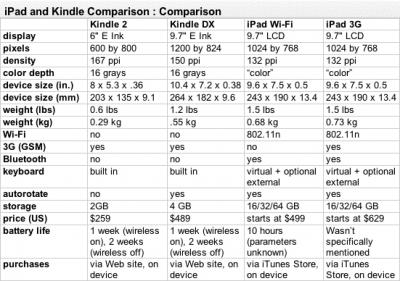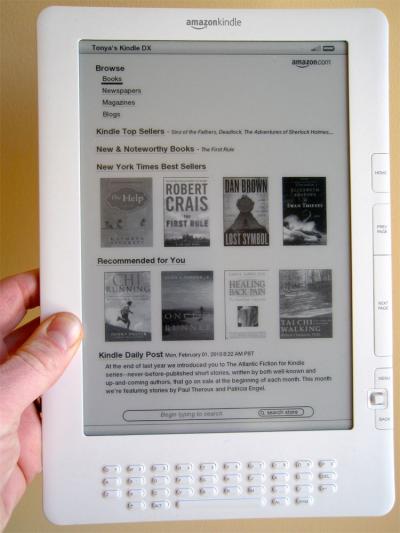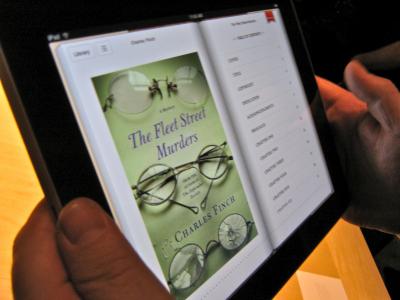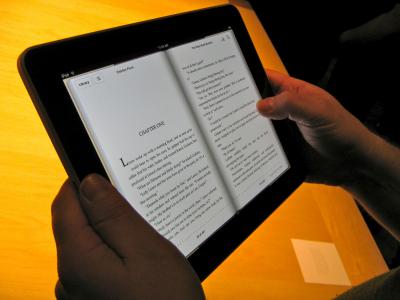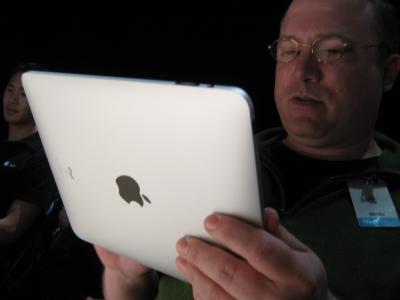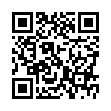Edit iCal Event Titles Directly
In the Leopard version of iCal, double-clicking an event shows a summary of the event, and to edit the name (or anything else), you must click the Edit button in the summary pop-up. To bypass the summary and edit pop-ups entirely, Option-double-click the event name. That selects the text for editing, and you can make any changes you want. Click outside the event to save your changes.
Written by
Adam C. Engst
Recent TidBITS Talk Discussions
- Alternatives to MobileMe for syncing calendars between iPad/Mac (1 message)
- Free anti-virus for the Mac (20 messages)
- iTunes 10 syncing iPod Touch 4.1 (2 messages)
- Thoughts about Ping (16 messages)
Related Articles
- Amazon Opens Kindle to Developers, Changes Royalties (21 Jan 10)
- Find Free and Inexpensive Wi-Fi (13 Jun 10)
- Amazon Extends Kindle Beyond United States (08 Oct 09)
Published in TidBITS 1013.
Subscribe to our weekly email edition.
- Keynote Editing in Action on the iPad
- New Ebooks Aid Remote Support, Collaboration, and Administration
- Can You Get By with 250 MB of Data Per Month?
- Solving the Universal Access Color Problem
- TidBITS Watchlist: Notable Software Updates for 8 February 2010
- ExtraBITS for 8 February 2010
Is the iPad a Kindle Killer?
Media companies leak like sieves, so it was known for a long time before the iPad announcement that Apple was having conversations with book, newspaper, and magazine publishers about what those firms would want in an ideal device and in ideal software. We saw the first fruits of those discussions at the iPad launch, with the New York Times demonstrating a hastily revised demo app, and with Apple's bundled iBooks app.
Apple didn't discuss magazine and newspaper subscriptions, but the New York Times demo showed that Apple was clearly looking to the existing app approach coupled with in-application or one-time fees to suffice for that model.
For books, however, there's a new app: iBooks. The program combines a bookstore and a bookshelf, enabling you to purchase books and download them for reading on the device. (The iBookstore was not yet enabled on the iPads available at the 27 January 2010 media event, so I couldn't test it.)
While the iPad has the potential to render the Amazon Kindle 2 and Kindle DX obsolete, Amazon's Kindle books are not limited to the Kindle itself; special software lets you read any book that's available for the Kindle on an iPhone or Windows system. (The Mac OS X software has been "coming soon" for many months now; BlackBerry software is still on the way.)
Both publication subscriptions and book sales put the iPad into direct competition with Amazon - for any profit Amazon makes from selling Kindle hardware readers and for the income from selling content.
The iPad will certainly run the Kindle for iPhone app, and Amazon may trump Apple on book pricing, as the Seattle book and media seller has so far been willing to subsidize the cost of lower-margin or negative-margin ebooks - books that cost them money to sell - to keep overall sales strong. But Apple's revenue split - apparently 70/30 for the publisher, just as with the App Store - trumps Amazon's current general 50/50 split for large publishers.
Since I can't evaluate iBooks on the basis of its available catalog, the shopping experience, or pricing, I have to focus on four elements: the reading and interface experience, the screen technology, networking and Internet access, and the desire of publishers to have more control and reap more profit from ebook sales than Amazon offers in the Kindle model.
For a head-to-head hardware comparison, I've compiled a small spreadsheet (which you can also view as a Google spreadsheet).
(Disclosure: I worked at Amazon for six months as a senior manager in 1996 and 1997. I left before I vested stock, and own no stock in either Amazon or Apple. Besides Jeff Bezos, I'm not even sure if anyone I worked with at the company is still employed there.)
Reading -- The simplest part of this whole ebook reader equation is the actual reading. No matter whether you're absorbing text on a Kindle device, the Kindle for iPhone app, or an iPad, there's little friction between you and the words.
Syncing, storing, and accessing library. The Kindle readers and iPhone software maintain a list of media you've downloaded. You can download media you've purchased but aren't currently storing at no additional charge. There's also no charge to sync over USB. Any Kindle software or hardware registered to your Amazon account can download and read any book you've purchased or media subscription (subject to hazy limitations).
iBooks might use iTunes to maintain its library, as iTunes manages music, podcasts, movies, and acts as a conduit for photo galleries; Apple has so far been unclear about whether or not iTunes will manage books too. Nonetheless, Apple will provide some software that will enable multiple iPhone OS devices under your control to sync books you've bought or loaded. Unlike Amazon, Apple considers it your problem to maintain and back up your media library; lost songs and videos can't be re-downloaded. Of course, the fact that iPhone OS devices back up every time they connect to a computer makes data loss less likely.
The interface for picking stored books to read on the iPad probably demonstrates at the outset what the Kindle is up against. You can see how book covers appear on a Kindle DX in this image. Contrast that with the iPad, which uses a bookshelf metaphor to show browsable shelves of full-color covers.
(I'd be remiss if I didn't note that Apple appropriated much of the look and feel of the bookshelves from Delicious Monster's Delicious Library software. That application didn't invent the concept of using bookshelves, but it seems clear where the iBooks app got its visual inspiration.)
Amazon and Apple use different digital rights management systems to prevent books from being read on other devices or in other software. Both platforms can, however, read unencrypted files in a number of major ebook formats. Amazon requires that such files be transfered via USB, or via a special email address dedicated to each Kindle reader that requires additional fees.
Apple hasn't yet explained how non-purchased ebooks can be added to the iBooks app. Apple supports PDF display in iPhone OS, but that's only as an email attachment or within programs like GoodReader, AirShare, or Dropbox that open stored files. It would be lovely if iBooks would manage and allow PDF reading.
Reading interface. The Kindle's main function is to read, and Amazon has made that process simple. Reviewers - including yours truly - expressed disdain for the original Kindle design, notably its poorly placed and sized previous/next buttons. The design was notably improved in the Kindle 2 and carried through to the Kindle DX.
Select a book to read, and the display opens in portrait view on the Kindle 2, or can auto-rotate to portrait or landscape (a single column's width) on the larger Kindle DX. Amazon tracks the last position you read in a book regardless of which device or software program you last used. If you switch from a Kindle reader to the iPhone app and then to Kindle for Windows, you never lose track of where you're at in the book.
On the Kindle hardware, changing pages involves using hardware buttons that you press to move forward or back. Other menus let you reach the table of contents. The E Ink hardware offers an irritating flash as the page is rewritten for each turn. For smaller changes - such as a menu appearing - only part of the screen is rewritten, the flash isn't noticeable, and the Kindle momentarily appears fast.
Words can be selected in a somewhat awkward manner using a stubby joystick and looked up in the dictionary. You can also search the contents of the book for matching words or phrases.
You can annotate selected text, and your annotations are stored and synced across whatever devices you own. Annotations can't be extracted from Kindle to other formats, however. You can choose among six sizes for type. Books are justified ragged right or fully across the page (leaving rivers of white) based on the publisher's preference, apparently, and cannot be changed.
The Kindle for iPhone app uses swiping gestures and a draggable position indicator to move through a book, and offers five type sizes from which to choose.
iBooks is equally simple, but designed around the multitouch experience. Tap a book in the bookshelf to read, and it opens to where you left off. We don't yet know if Apple will sync the last-read position among devices registered to your account, but that's the behavior used for listening to podcasts and audio books. You tap or swipe to go backwards and forward through the book. Swiping slowly lets you see the page curl and turn. You can select among five fonts and several sizes to read books. You can also quickly navigate to the cover and table of contents.
iBooks shows either a single page in portrait view or side-by-side pages in landscape orientation. Black-and-white and color images, as well as video, can be embedded in books, although I didn't see any video in the sample books I looked through. Full justification appears to be the only formatting option.
The version of iBooks I saw is certainly not what will ship, but the omissions at the launch event were notable: no annotations or highlighting, no way to look up references, and no bookmarks. There was a search icon, but the feature wasn't yet activated.
Amazon got around the "where in the book am I?" problem by indexing a book using reference locations. These reference units allow sync across devices by referring to the same unit, regardless of format and type choice.
Apple, so far, is using absolute page numbers derived from the current typeface and size. This would make it difficult to refer to a precise location in an iBooks title, and would be a particular problem with textbooks that may appear in ebook and print formats and be used interchangeably by the same students in a class. Nevertheless, most readers won't care at all, since by far the main use of page numbers in the real world is to remember your place in a book, something the iBooks app should just do for you.
Screen versus Screen -- Amazon made hay from using the E Ink screen for its Kindle, despite the technology's previous inclusion in the Sony Reader. E Ink has a tremendous advantage over LCD displays in two ways: persistence without battery drain, and no need for backlighting.
When pixels are changed from one shade to another, the screen technology causes a fixed physical change, as opposed to varying the charge applied as in an LCD display. An E Ink display's image remains in place without any additional power consumed. That's a big reduction in battery use right there.
The relatively high contrast without backlighting also makes for easier reading for some people - many of our friends on Twitter swear by the ease of E Ink screens on their eyes - while also consuming less power than a backlit LCD. Like paper, the screen can be read from varied viewing angles, too.
However, those two advantages seem to be eroding. The iPad uses a color LCD with a wide range of viewing angles. I noticed the angle issue at the iPad launch: you could see an iPad at an extreme rotation and still make the screen out clearly, even from many feet away, or hold one up closely and move it around without losing screen acuity.
We have only Steve Jobs's word so far on battery usage: he said 10 hours, and apparently meant 10 hours of real usage, as he cited watching movies from San Francisco to Tokyo. If so, that's a huge improvement over any comparably sized and featured device.
While the Kindle devices promise one week of reading with the wireless 3G modem turned on and two weeks with it turned off, the Kindle is used for far fewer activities. I'd imagine that with wireless off and just reading, the iPad will have a far longer lifetime than the 10 hours cited. You can also adjust backlighting on the iPad to reduce battery drain, just as on an iPhone or iPod touch.
The use of an LCD allows books to include videos and full-color images, which makes possible the correct reproduction of certain types of books, like graphic novels and anatomical textbooks, which simply wouldn't work on the Kindle's grayscale screen.
I have no trouble reading a backlit display all day long, but as noted above, many people seem to prefer the Kindle, noting especially how well the Kindle readers work in daylight conditions. LCDs often perform poorly with any kind of direct light or glare. Whether this advantage of the Kindle screen is significant depends on your usage patterns. If you do a lot of reading at the beach, it's important, but if you prefer a comfortable couch inside, it's largely irrelevant. On the flip side, reading on a Kindle in bed requires additional light, whereas the backlit iPad won't.
From the screen size and pixel density standpoint, the difference isn't great.
- The Kindle 2's 6-inch screen (measured diagonally) has 600 by 800 pixels at a 167 pixel-per-inch (ppi) density.
- The Kindle DX has a 9.7-inch screen, 1200 by 824 pixels in size, and a 150 ppi density.
- The iPad uses a 9.7-inch screen with 1024 by 768 pixels at a 132 ppi density.
The iPhone and similar smartphones have about a 167 ppi display, while newer phones, like the Droid, feature even higher resolutions. The higher you go, the closer to paper a display resembles: type and graphics appear smoother.
I didn't notice any artifacts except in the page curl in iBooks with the lower-density iPad screen.
Networking -- Amazon broke through the indifference to ebook readers by building a cellular modem into every Kindle. More recently, it switched its carrier partner and modem technology from Sprint, which uses a network standard widely employed only in the United States, to AT&T, which uses the worldwide dominant GSM standard. Both current Kindle 2 and DX versions use the GSM modem and can work (with different delivery prices) on over 100 GSM networks worldwide.
Amazon lets you use the cell modem only to purchase and download content or subscribe to paid content. Free content that can be converted or read in native format on the Kindle 2 or DX must be transferred while the Kindle is plugged in via USB to a computer. The Kindle mounts as a USB drive, and synchronization is manual. On the other hand, you don't have to sync the Kindle to a particular machine. You can also send documents to your Kindle via email, at a cost of 15 cents per megabyte, rounded up to the next whole megabyte.
Amazon's avoidance of Wi-Fi is odd, because Wi-Fi networks are abundant, and ever more of them have turned free-with-purchase or entirely free. (See "Find Free and Inexpensive Wi-Fi," 23 December 2009.)
The iPad will come in two versions. The less-expensive flavors, with price determined by built-in storage, have only 802.11n Wi-Fi, the fastest wireless networking version currently available, and one that is supported by all three Apple base station models released since 2007. As with the iPhone and iPod touch, it seems clear that you won't be able to sync media over Wi-Fi, however, but must instead use USB to connect to a single copy of iTunes.
Apple will also offer iPad models that support 3G technology, using GSM as in the iPhone and adding $130 to the price of each iPad, but requiring no service plan on purchase and no service contract for use in the United States.
Amazon bundles the cost of each download into the price of the books and subscriptions it sells; it's probably pennies per transaction given the 15 cents per megabyte cost Amazon quotes in general. Apple, by contrast, struck a deal with AT&T to allow 250 MB of use per month for $14.99 and unlimited use each month for $29.99. For a general-purpose device, this makes far more sense as a plan, of course. (AT&T's 3G service is coupled with free Wi-Fi access at its 20,000-plus hotspots, although nearly 12,000 of those are McDonald's restaurants that have already switched to free service as of mid-January 2010.)
Given that Apple is requiring iPad purchasers to pay the cost of Internet transport, Apple has no secondary payments to network operators, giving it a small slice of additional revenue to play with when pricing books.
The Kindle fares far more poorly in its network pricing outside the United States. Amazon charges a small fortune - sometimes dollars per book - for downloads of books on a U.S. Kindle taken overseas, and for titles purchased on non-U.S. Kindles in the country in which the Kindle was bought (see "Amazon Extends Kindle Beyond United States," 8 October 2009).
Apple will have no such problem. Wi-Fi can always be used as an alternative to 3G. Apple will strike carrier-specific deals akin to the AT&T arrangement as it expands its 3G plans for the iPad outside the United States later this year.
Publishers -- This last of these four elements is the trickiest, because it's not about you - unless you run or work for a media company - but about the book, magazine, and newspaper companies that are worried in various ways about the future of their industries.
Yes, the biggest of these firms used to reap huge profits and control their fortunes; now, newspapers in particular appear to be sliding down a ramp into bankruptcy and obsolescence. That's why the iPad has assumed disproportionate interest - especially among the newspapers covering Apple.
Amazon may have sold "millions" of Kindles according to a remark by company founder Jeff Bezos, but that's still a drop in the electronic bucket. The Kindle penetration couldn't begin to produce enough revenue on the subscription side, even if it's pulling in many millions of dollars of ebook revenue. (Bezos said millions of people own Kindles, but his choice of words might mean he's counting all members of households that have Kindles as "owners." Consumer electronics analysts have pegged the Kindle at more like a million units sold to date, and Amazon has coyly refused to give solid sales figures.)
Publishers also hate Amazon's terms on subscriptions and book pricing. Amazon gets 70 percent of the revenue from subscriptions, which seems excessive for what it delivers. The reason there are so few subscriptions available on the Kindle - relative to the number of periodicals in the world - is that Amazon hasn't offered a particularly compelling deal.
Media firms don't want to get locked into the bad revenue split, and can already get visitors to their sites where they display advertising that provides direct revenue. The New York Times earned $100 million in online advertising in 2008, according to the Wall Street Journal.
Apple plans to flip the revenue split around, although, so far, it doesn't seem to be on the path to offer automatic downloading of new content. Kindle subscriptions include downloading new media content as it's released, so you don't need a network connection at the time you want to read the latest New York Times article.
At the iPad launch event, representatives from the New York Times showed off a hastily revised iPhone app that took advantage of the larger screen for better layout, integral videos, and other elements. The model Apple is pushing is clearly that periodical publishers should create custom iPhone OS apps designed for the iPad, and Apple will keep 30 percent of subscription revenue as it does now for in-app purchases and flat-rate app sales.
Because Apple hasn't released any specific information about periodical subscriptions, I'm reading the tea leaves and extrapolating, of course.
Book revenue is trickier. For major publishers, Amazon pays 50 percent of the list price of the current cheapest print format book. If a book is only in hardcover - a new release like a Dan Brown blockbuster - the cover price might be $30 and Amazon pays $15. When that book goes into paperback format and sells for $12, Amazon pays just $6.
However, Amazon wants ebooks to be cheap, and thus charges $9.99 for books still available only in hardcover. It subsidizes the price of these books to set the overall price low, and reaps its profit margins from cheaper books for which it makes its full 100-percent markup - or even more. Since Amazon is the dominant ebook seller, it may be using that position to charge more than double its wholesale cost for less-expensive books.
Just before the iPad launch, Amazon offered a new set of terms for smaller publishers that gives 70 percent to the publisher, in exchange for a requirement that the book is priced between $2.99 and $9.99, isn't sold for less at other ebook stores, and is at least 20 percent below the cheapest print edition. (See "Amazon Opens Kindle to Developers, Changes Royalties," 21 January 2010.)
Apple reportedly wants just 30 percent of subscription and ebook revenue, and doesn't want to set book prices, although the $13 to $15 range is more likely to be the top instead of the $10 line Amazon has tried to hold.
As I write this, Amazon is fighting a public battle with Macmillan, one of the largest U.S. publishers. Macmillan wants to set a higher list price for newly published books as they appear in electronic form (that $13 to $15 mentioned earlier) and give Amazon 30 percent of that list price. If Amazon doesn't want the new terms, Macmillan would offer a far smaller catalog than it currently provides when it starts its new ebook pricing system in March 2010. (Macmillan is one of the five publishers Apple said it had signed up at the iPad launch.)
Macmillan is in part trying to prevent the erosion of revenue from the big push for new big books in hardcover. If Amazon can sell such titles for $9.99, even at a loss, and even if Macmillan makes $15 from Amazon selling at that price, it sets the wrong expectation, and overturns some of the economics for both blockbusters and mid-range books. (The blockbusters' margins make possible the more interesting books that sell vastly fewer copies.)
Amazon balked, and not only pulled Macmillan's ebook titles, but also stopped selling all Macmillan print books temporarily. That's the biggest hissy fit I've ever seen a company pull. Macmillan's head issued a letter to its authors and illustrators (and their agents) which noted that what Macmillan wants is control over its own destiny. I also like author John Scalzi's take in "Amazon.fail," in which he enumerates the contempt shown by the firm.
On the face of it, this seems like a bad deal for consumers. Wouldn't you rather pay $10 than $15 for a book? Absolutely. But in the long run, Amazon would achieve de facto control over book pricing, which would hurt small and large publishers. It also locks in users who become accustomed to lower prices.
But it's not that Macmillan wants to sell books for $13 to $15 forever; rather, "Pricing will be dynamic over time." That is, Macmillan can price books in response to demand, instead of being stuck in whatever pricing system Amazon wants to impose; it frees Macmillan and Amazon from structuring pricing around print book list prices, too.
With more control on the supply side, Macmillan can reduce prices as demand lessens. Those who desperately want a book immediately might pay $15 at its launch; Macmillan would also guarantee print and ebook editions would be issued at the same time. If you can wait, you might pay less and less.
As science-fiction writer Charlie Stross - who writes for a Macmillan imprint and whose own books were pulled - wrote, "Such a system would allow them to get a lock on the price elasticity of demand, and thus work out the price point at which they can maximize book sales."
This is good for readers, writers, and publishers, as well as ebook distributors, including Amazon and Apple. More books will be sold this way, and more revenue directed at the creators, not the middlemen.
For its part, Amazon is saying this is about Macmillan setting its ebook prices "needlessly high." But the firm also notes, "Amazon customers will at that point decide for themselves whether they believe it's reasonable to pay $14.99 for a bestselling e-book." That's right: they will! That's how the market works. And because Amazon can sell Kindle ebooks to read on an inevitable updated Kindle app for iPad, we can see market choices directly on that one device.
Amazon said it will capitulate to Macmillan's pricing structure, but as I write this only the print editions of Macmillan's titles have been restored for purchase; ebooks remain "shelved."
Part of my interest in this area is that the "in-print" catalog of ebooks from Amazon, Sony, and Barnes & Noble remains pitifully small compared to all in-print books. There are perhaps as many as three million books available from the trade and publishers in the United States, but Amazon offers fewer than 10 percent in its catalog. The reason is partly its revenue split and interest in control of the market.
I suspect that Apple's emergence into the ebook market precipitated this Amazon temper tantrum. Apple may be able to offer publishers more of what they want than Amazon, and Amazon is freaking out. Apple, after all, has not viewed music, video, or app sales as profit centers; instead, the company's approach is to sell devices (with higher margins), like the iPad and iPhone, that excel at playing media. (Amazon's behavior reminds me strongly of this November 2007 Crazy Apple Rumors Site parody article, "Apple e-Book Reader Captures the Market." [Language not safe for work.])
Kindle Co-opetition -- In the end, Amazon is a bookseller, and its foray into hardware shows that it's better at moving media than making machines. The Kindle has evolved into a nice piece of hardware that gets great reviews from those who keep it.
But, put bluntly, the Kindle DX just doesn't compare favorably with the iPad in any way other than battery life and screen visibility in sunlight; the Kindle 2 benefits from being smaller and cheaper. And the Kindle ebook library may offer titles at a lower price, though Amazon may be forced to capitulate on that.
When the iPad ships, we can get a better sense of how it will be received. If most people consider it a glorified book reader with a Web browser, then the ebook portion of the iPad may be vastly more important than if people instead see it as a new kind of computing device in which ebooks are just another bullet point.
It's interesting to note that Apple's dominance of the downloadable digital music market led music publishers to cut deals with Walmart, Microsoft, and Amazon to provide full catalogs without any digital rights management - partly because Apple refused to compromise on pricing!
The music publishers forced a crack in the digital music world, and incidentally gave us what we wanted in terms of removing DRM from music, while creating a range of music and album prices that averaged just above what the one-price-fits-all model had previously provided.
Strange that Amazon doesn't see the poetic reflection.
 With ChronoSync you can sync, back up, or make bootable backups.
With ChronoSync you can sync, back up, or make bootable backups.Sync or back up your Mac to internal or external hard drives, other
Macs, PCs, or remote network volumes you can mount on your Mac.
Learn more at <http://www.econtechnologies.com/tb.html>!
I mention it here in part because the control is so well hidden that Kindle owners may not have found it. The feature is hidden in the font size selector (the AA button to the right of the spacebar).
Click that button, and find the "Screen Rotation" selection at the bottom of the resulting dialog. (Landscape is a useful setting for many PDFs, including the Take Control books I've sampled--give it a try.)
The iPad allows you to upload eBooks in multiple formats for FREE. You don't have to pay 99 cents per megabyte to do this as you would with the Kindle to upload your own books..
The iPad allows multiple eBook formats. You can get eBooks in Apple's iBook ePub format. You can read Kindle eBooks. You can read PDFs, Microsoft Word, Text, Palm Doc, and other formats. If you bought books with your Palm Pilot, you can read them on the iPad. You can purchase textbooks for college via Courseware's textbook app. You can even read free virtual books via Google's Google Books in FULL COLOR. With Google Books on the iPad, you don't even have to buy books to read them. You read them online.
The iPad has much more functionality than the Kindle. You can get Apple's iWork apps and create Microsoft compatible .doc and Excel spreadsheet files. You can transfer these to PCs - via its doc or via eMail or via WiFi transfer etc. You can get apps that allow you to print from the iPad. Of course, you can watch video, listen to your music, surf the net in FULL color, play HD video games, and run the more than 140,000 and growing number of apps. You can even use it as a thin client to run your desktop computer or server from a virtual window via the internet or WiFi. The possibilities are endless.
The fact that you can do so much more with the iPad than the Kindle (even outdoing the Kindle in the number of books you can access on it - with thousands and thousands that are free - such as Google's ePubs) makes the iPad the Kindle Killer.
Frankly, for most customers the devices just aren't in the same category . The iPad's LCD screen is a plus for watching video or interactive applications, sure, but it's a minus when reading a book--e-ink is, hands down, a better display technology for reading large volumes of text. The 10-hour battery life of the iPad is great compared to a laptop, but it's not so great compared to the week-long-plus battery life of the Kindle or the nook.
And the Kindle, nook and sony ereaders (I am not personally familiar with other companies' products) all read epubs and have plenty of ways to get books from Google or other sources for free, contrary to Mr. Katt's assertion.
Fact is, the iPad will be better for some people, and an e-ink device for others.
Of course, the iPad has other uses, not even thought about by Amazon. I think that the two devices don't really compete at the present time.
Thanks!
Amazon owns Audible, so I've never been clear why it wouldn't try to cross-sell audio books at a heavy discount to those who buy Kindle titles.
Apple has no such advantage, but already sells Audible and other audio books via iTunes, so would be likely to help cross-sell that material.
I now use my iPod Touch for occasional reading and whenever possible I download free audiobooks from LibriVox, which I love!
I wanted to like the Kindle, but never could. I just wish I had a reason to get an iPad. Since I don't travel and now have an iPod, a MacBook and an iMac, I haven't found a reason (other than lust) yet. But I do know many other senior citizens who will get one primarily for its superior (for us) reading capabilitiesabilities.
"Apple's revenue split - apparently 70/30 for the publisher, just as with the App Store..."
So that's 20 percent more of the price to the publisher or author than Amazon's 50-50.
Also, Amazon's 50-50 split was forced upon them by the publishers, who had enough control to prevent Amazon setting terms. But publishers were pricing 50-50 on the cheapest in-print book, so in the new model Amazon comes out ahead.
That is, Amazon paid Macmillan $15 to sell an ebook that was only available in print as a $30 hardcover. Amazon sold that for $10 and lost money. In the new model, Macmillan will charge $10.50 for a new ebook that sells for a list price of $15 (regardless of hard cover status), and Amazon will receive $4.50.
http://dpakman.wordpress.com/2010/02/03/wading-in-on-amazonmacmillan-pricing-debate/
Only time will tell.
-
I have read on my daughter's Kindle. Several people at work have iphones. Epaper screens are much more then simply something visible in sunlight. You read the epaper by reflective light. Eyes are designed to see by reflective light. It is uncomfortable to read for long periods of time on LCD screens because that they are a projective light source. My Opthamologist says projective light causes your blink rate to change and become an issue for vision. Color LCD screens look prettier but are tiring for hours of reading Epaper gray scale screens are not suitable for gaming and video but are the eye comfort winner as a substitute for reading a stack of paperback books on a six hour flight.
What I want is a Kindle that allows highlighting and scribbling margin notes with a stylus. As Orinthe says, the iPad is in a different category.
Now, I try to be generally jaundiced about pricing promises, and Macmillan does have a "monopoly": it is the only source of rights for specific titles, and most people don't buy books in a category, but rather an exact item.
But I think with a vastly larger supply of books, a larger audience, and the "zombie author" threat that Chris Pepper wrote about recently here on TidBITS, there will be market effects that will tend to push the price of older books to lower levels.
Where this really takes off for the publishers is the long tail, where maintaining inventory is expensive (even with new print-on-demand options), and yet with 50,000 or more titles available, the publisher can reap real revenue from ongoing sales of books without the commensurate cost of inventory, new short print runs, and returns.
So the Kindle is by no means doomed.
As for the bookstores, it will take a long time for Apple to catch up to Amazon and the Kindle App, I think. It's my understanding that the iBook App won't even have bookmarking. I expect to do a lot of my iPad reading on the Kindle App. And, of course, on Instapaper.
The iPad will have bookmarking; it just wasn't implemented in the pre-release demo versions we got to use at the launch event.
If you're buying the iPad solely as an ebook reader, then the costs are in favor of the Kindle. But that also assumes you won't be using the Web browser or email on the 3G version, which makes a big difference. Although the Kindle does have a Web browser, from what I understand it's really pathetic and unusable.
I do agree that the Kindle is not doomed. We like healthy competition. But I think the iPad is going to make Amazon dramatically rethink what the Kindle is.

